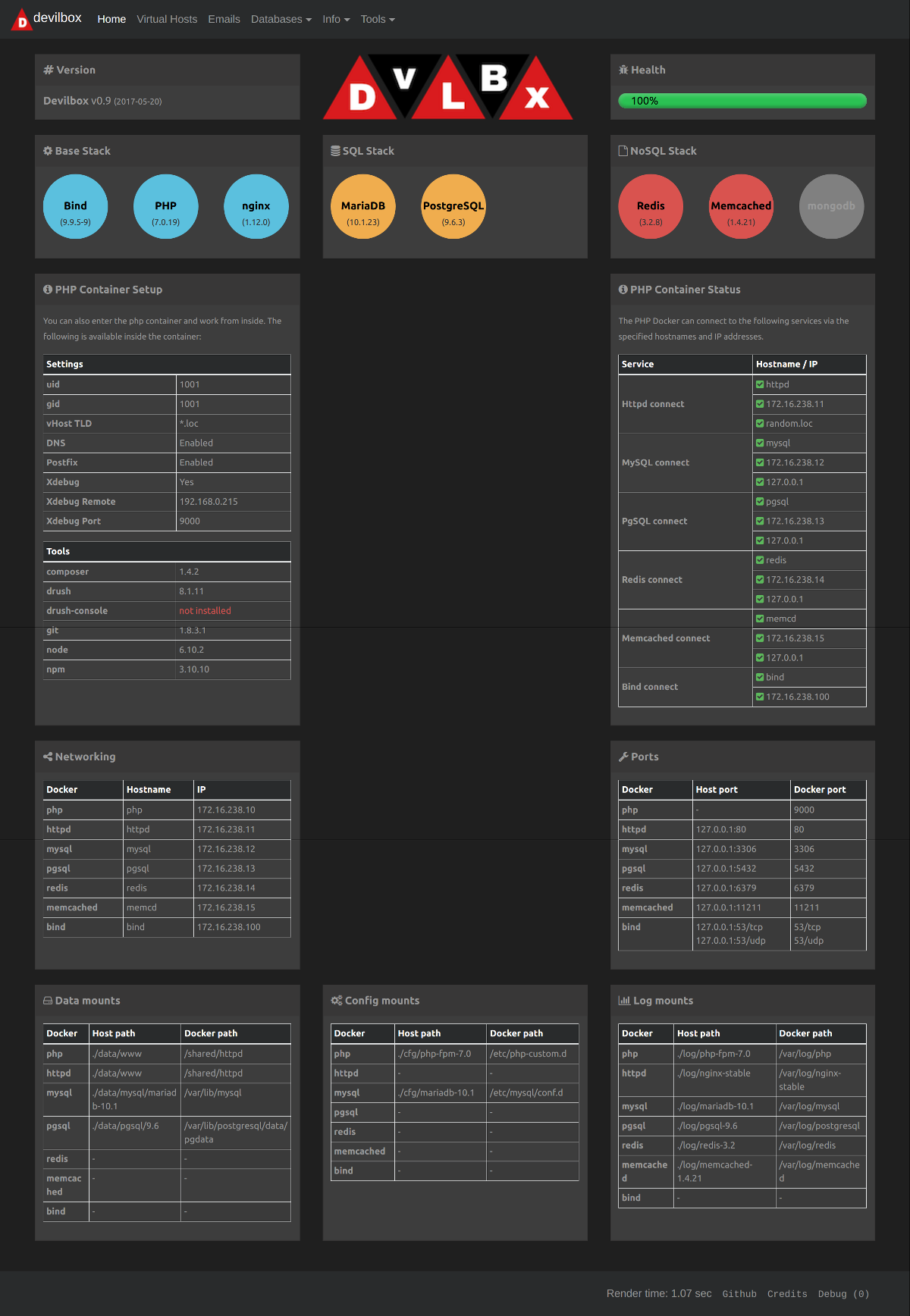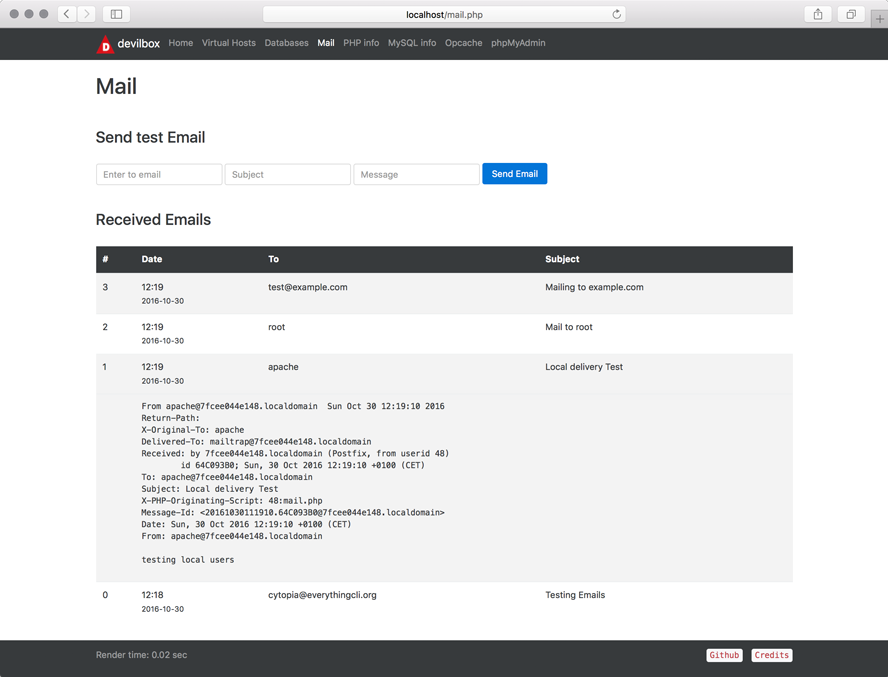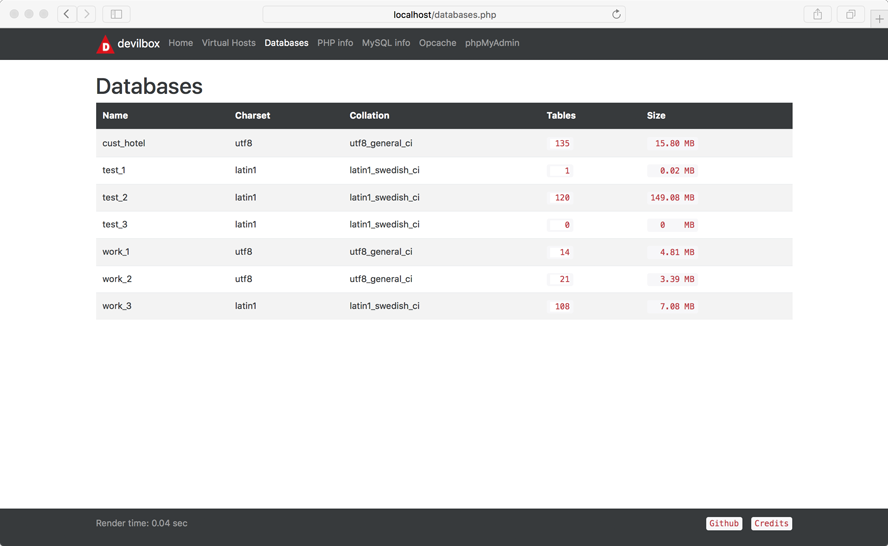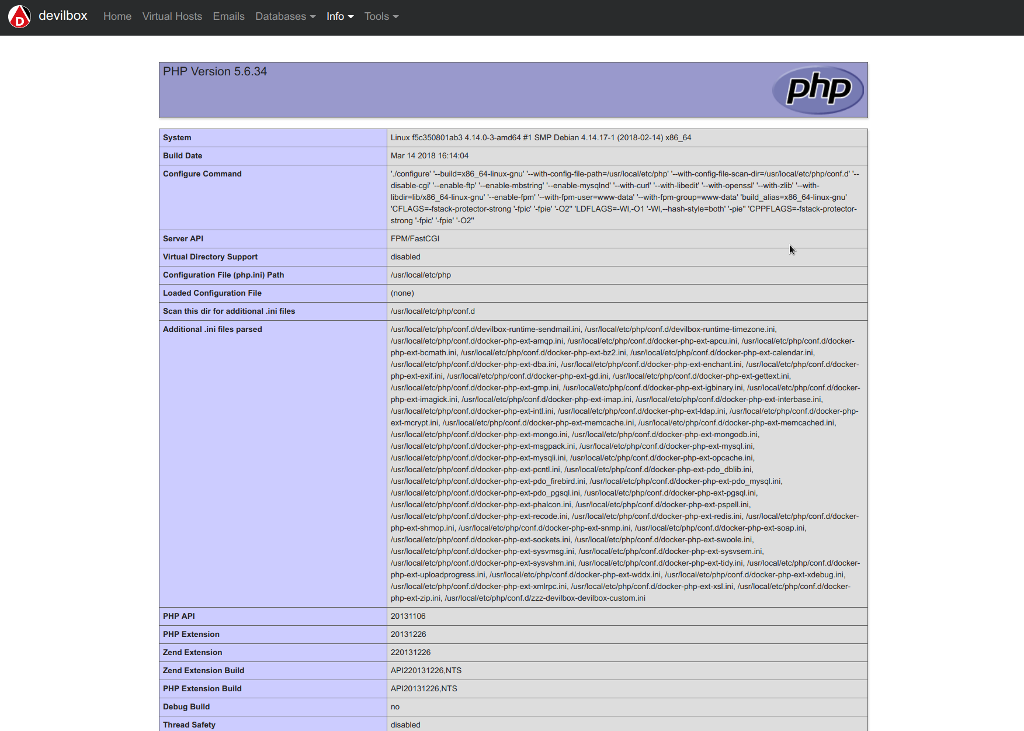Attention
You can now run different PHP versions per project:
Release v3.0.0-beta-0.1 ![]()
4. Devilbox intranet¶
The Devilbox intranet is your command & control center showing all kinds of information and settings currently in effect. It also offers third-party projects to do all sorts of database manipulation.
Table of Contents
4.1. Devilbox tools¶
4.1.1. Overview¶
The start page is there to check if everything works as expected. It shows all desired Docker
containers you wanted to start and if they succeeded, as well as their ports, mount points and
special settings applied via .env.

Devilbox intranet: homepage
4.1.2. Virtual hosts¶
The virtual host page displays all available projects and let’s you know if their configuration is correct, such as DNS settings or document root.

Devilbox intranet: available virtual hosts
4.1.3. Emails¶
The email page displays all emails that would have been sent, but were caught by the integrated email catch-all functionality.

Devilbox intranet: email catch-all overview
4.1.4. Databases¶
There are several database pages for MySQL and NoSQL databases giving you an overview about what is currently in place, how many databases/schemas and or recors and what size they take up.
The following example shows the database page for MySQL:

Devilbox intranet: MySQL database overview
4.1.5. Info pages¶
Info pages also exist for every Docker container which show various settings which are currently applied.
The following example shows you the info page for PHP.

Devilbox intranet: php info
The following example shows you the info page for MySQL:

Devilbox intranet: MySQL info overview
4.2. Third-party tools¶
4.2.1. Adminer¶
Adminer ![]() (formerly phpMinAdmin) is a full-featured database
management tool written in PHP. Conversely to phpMyAdmin, it consist of a single file ready to
deploy to the target server. Adminer is available for MySQL, MariaDB, PostgreSQL, SQLite, MS SQL,
Oracle, Firebird, SimpleDB, Elasticsearch and MongoDB.
(formerly phpMinAdmin) is a full-featured database
management tool written in PHP. Conversely to phpMyAdmin, it consist of a single file ready to
deploy to the target server. Adminer is available for MySQL, MariaDB, PostgreSQL, SQLite, MS SQL,
Oracle, Firebird, SimpleDB, Elasticsearch and MongoDB.
4.2.2. phpMyAdmin¶
phpMyAdmin ![]() is a free software tool written in PHP,
intended to handle the administration of MySQL over the Web. phpMyAdmin supports a wide range
of operations on MySQL and MariaDB. Frequently used operations (managing databases, tables,
columns, relations, indexes, users, permissions, etc) can be performed via the user interface,
while you still have the ability to directly execute any SQL statement.
is a free software tool written in PHP,
intended to handle the administration of MySQL over the Web. phpMyAdmin supports a wide range
of operations on MySQL and MariaDB. Frequently used operations (managing databases, tables,
columns, relations, indexes, users, permissions, etc) can be performed via the user interface,
while you still have the ability to directly execute any SQL statement.
4.2.3. phpPgAdmin¶
phpPgAdmin ![]() is a web-based administration tool for PostgreSQL. It is perfect for
PostgreSQL DBAs, newbies, and hosting services.
is a web-based administration tool for PostgreSQL. It is perfect for
PostgreSQL DBAs, newbies, and hosting services.
4.2.4. phpRedMin¶
phpRedMin ![]() is a simple web interface to manage and monitor your Redis.
is a simple web interface to manage and monitor your Redis.
4.2.5. PHPMemcachedAdmin¶
PHPMemcachedAdmin ![]() is a simple web interface to manage and monitor your Memcached.
is a simple web interface to manage and monitor your Memcached.
4.2.6. OpcacheGUI¶
OpcacheGui ![]() is a clean and responsive interface for
Zend OPcache information, showing statistics, settings and cached files, and providing a real-time
update for the information (using jQuery and React).
is a clean and responsive interface for
Zend OPcache information, showing statistics, settings and cached files, and providing a real-time
update for the information (using jQuery and React).
4.3. Settings¶
4.3.1. Password protect the intranet¶
If you share your projects over a LAN, but do not want anybody to view the Devilbox intranet, you can also password protect it.
See also
In order to do so, have a look at the following .env variables:
4.3.2. Disable the intranet¶
If you want a more production-like setup, you can also fully disable the Devilbox intranet. This is achieved internally by removing the default virtual host which serves the intranet. When the intranet is disabled, there is no way to access it.
4.4. Checklist¶
- You know what tools are provided by the Devilbox intranet
- You know how to password protect the Devilbox intranet
- You know how to disable the Devilbox intranet
See also